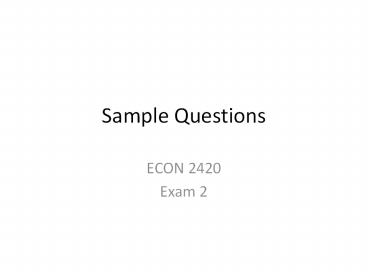Sample Questions - PowerPoint PPT Presentation
1 / 20
Title: Sample Questions
1
Sample Questions
- ECON 2420
- Exam 2
2
Demand Elasticities
- If EP -3, what does this mean?
- A 1 Price increase causes Quantity to decline 3
- If Price increases by 10 and EP -5, then Q
- Will decrease by 50
- If demand is relatively price elastic, then
absolute value of EP is - gt 1, lt 1, 1
- Where EP is the price elasticity of demand
3
Demand Elasticities
- If demand is perfectly price elastic, then the
absolute value of EP is - Infinity, gt 1, lt 1, 0.
- If demand is perfectly price inelastic, then the
absolute value of EP is - Infinity, gt 1, lt 1, 0.
- If Price increases by 15 and Quantity falls by
10, then demand is - Relatively price elastic, relatively price
inelastic, perfectly price elastic, perfectly
price inelastic
4
Demand Elasticities
- The price elasticity of demand along a downward
sloping linear demand curve is - Relatively elastic at high prices, relatively
inelastic at low prices - Perfectly elastic at very high prices, perfectly
inelastic at very low prices - Unit elastic everywhere
- Relatively inelastic at high prices, relatively
elastic at low prices
5
Demand Elasticities
- Demand for gasoline in the short run is
- Inelastic because there are no good substitutes
- Elastic because there are many substitutes
- Inelastic because there are many substitutes
- Elastic because there are no good substitutes
- With price elastic demand, a decrease in price
causes Total Revenue to increase because - Quantity increases enough to offset the decrease
in P
6
Demand Elasticities
- If price increases and Total Revenue falls
- Demand is relatively price elastic
- If price decreases and Total Revenue stays the
same - Demand is unit elastic
- If price increases and Total Revenue increases
- Demand is relatively price inelastic
7
The Relationship Between Price Elasticity and
Total Revenue
8
Demand Elasticities
- Suppose demand is a downward sloping curve. If
demand decreases, then the decrease in price - Is greater, the more elastic supply
- Is not affected by supply elasticity
- Is smaller, the more elastic supply
- Is always proportional to the decrease in demand
9
The Price Elasticity of Supply
Using Price Elasticity of Supply to Predict
Changes in Price
10
What Are Firms?
- Definitions of ownership types
- Advantages and disadvantages of each
- Coupon rate on bond
- 50 payment on 1,000 bond 5
- Explicit and Implicit Costs Economic Costs and
Accounting Costs - Economic Profit Revenue all costs of
production
11
Types of Firms
Who Is Liable? Limited and Unlimited Liability
SOLE PROPRIETORSHIP PARTNERSHIP CORPORATION
Advantages 1. Control by owner 2. No layers of management 1. Ability to share work 2. Ability to share risks 1. Limited personal liability 2. Greater ability to raise funds
Disadvantages 1. Unlimited personal liability 2. Limited ability to raise funds 1. Unlimited personal liability 2. Limited ability to raise funds 1. Costly to organize 2. Possible double taxation of income
12
The Structure of Corporations and the
Principal-agent Problem
Corporate governance The way in which
corporations are structured and the impact a
corporations structure has on the firms
behavior.
Corporate Structure and Corporate
Governance Separation of ownership from
control In many large corporations the top
management, rather than the shareholders, control
day-to-day operations. Principal-agent problem
A problem caused by an agent pursuing his own
interests rather than the interests of the
principal who hired him.
13
How Firms Raise Funds
Sources of External Funds STOCKS Stock A
financial security that represents partial
ownership of a firm. Dividends Payments by a
corporation to its shareholders. Capital gains
Increases in the value of a firms shares. Stock
and bond markets provide capitaland information.
14
Behavioral Economics
- Economists assume consumers goal is to make
themselves as well off as possible - Ultimatum Game People (both Allocator and
Recipient) care about fairness - Fairness pricing by business charging less than
the equilibrium price - Network externality the more people use a thing,
the more people want it
15
Behavioral Economics Do People Make Their
Choices Rationally?
Behavioral economics The study of situations in
which people make choices that do not appear to
be economically rational.
Consumers commonly commit the following three
mistakes when making decisions
- They take into account monetary costs but ignore
nonmonetary opportunity costs. - They fail to ignore sunk costs.
- They are overly optimistic about their future
behavior.
16
Production and Costs
- Long Run all inputs variable
- Short Run at least one input fixed (capital)
- ATC TC/Q MC ?TC/?Q
- MPL change in quantity when one more worker is
hired - Law of Diminishing Returns
- ATC MC are U-shaped in the short run, MPL
declines - TFC is cost that does not change with output
17
Production and Costs
- Identify ATC, AVC, AFC, and MC on a graph
- See graph
- LAC is U-shaped because of economies and
diseconomies of scale - Define LAC, MES, and constant returns to scale
- See next page
- Find MES on a graph
- See graph
18
Graphing Cost Curves
19
Definitions
- Long-run average cost curve A curve showing the
lowest cost at which the firm is able to produce
a given quantity of output in the long run, when
no inputs are fixed. - Economies of scale Economies of scale exist when
a firms long-run average costs fall as it
increases output. - Constant returns to scale Constant returns to
scale exist when a firms long-run average costs
remain unchanged as it increases output. - Minimum efficient scale The level of output at
which all economies of scale have been exhausted. - Diseconomies of scale Exist when a firms
long-run average costs rise as it increases
output.
20
Costs in the Long Run
Long-Run Average Total Cost Curves for Bookstores

